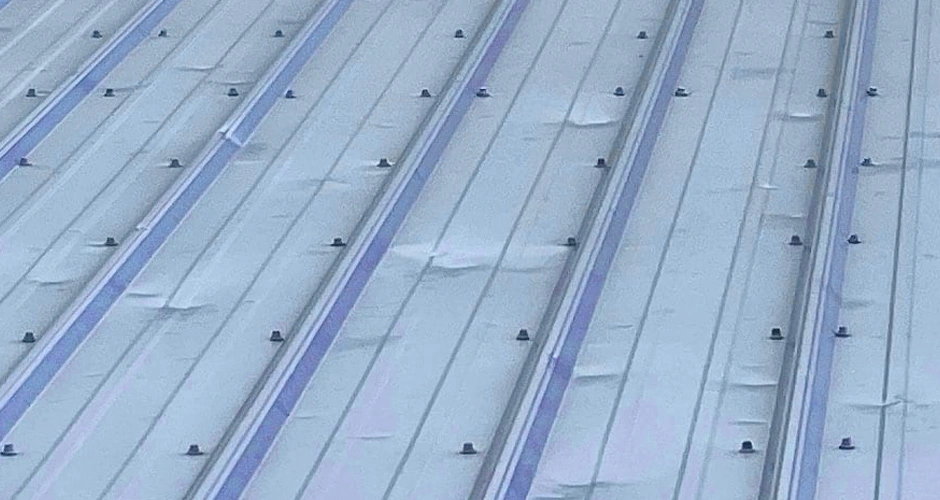Hail damage can wreak havoc on your roof in a matter of minutes, leaving your home exposed to the elements. The loud, sharp sounds of hailstones striking your roof during a storm can be unnerving, and unfortunately, the damage they leave behind isn’t always immediately visible.
A home that isn’t protected against hail damage can suffer leaks or structural problems as a result of ignoring the signs. Help protect your home by understanding what hail damage looks like and acting quickly.
What is Hail Damage?
During hailstorms, hailstones, which vary in size from tiny pebbles to large golf balls, can hit your roof with force, cracking, denting, or breaking your shingles, tiles, or metal panels. Even if the damage isn’t obvious at first, it can compromise your home’s ability to protect it from the elements, even if it isn’t immediately noticeable.
Signs of Hail Damage on Your Roof
After a hailstorm, it’s crucial to inspect your roof to check for any signs of hail damage. Here are some key indicators to look out for:
1. Dented or Cracked Shingles or Tiles
The most obvious sign of hail damage is visible dents or cracks in your roof shingles or tiles. These dents might be small, but they can lead to more severe problems if left unaddressed. For tiled roofs, look for chipped or cracked edges where the hailstones may have struck.
2. Granule Loss on Asphalt Shingles
Hailstones can knock the protective granules off asphalt shingles, leaving bald spots that make your roof vulnerable to UV rays and water damage. If you notice granules accumulating in your gutters or around the base of your home, this could be a sign of hail damage.
3. Dents in Metal Flashing or Gutters
Metal roofing, flashing, and gutters are not immune to hail damage. Check for dents or dimples in these areas, which can indicate that hail has struck your roof with enough force to cause potential damage.
4. Damage to Roof Vents and Skylights
Hail can damage more than just your shingles or tiles. Roof vents, skylights, and other fixtures are also susceptible to damage. Look for cracks or dents in these areas as part of your inspection.
5. Water Leaks Inside Your Home
If you notice water stains on your ceilings or walls after a hailstorm, it could indicate that hail damage has compromised your roof’s waterproofing. Even small holes or cracks in your roof can allow water to seep in, leading to leaks and mould growth over time.

What to Do If You Spot Hail Damage
If you’ve identified any signs of hail damage on your roof, it’s important to act quickly. Here’s what to do next:
1. Document the Damage
Take photos of any visible hail damage to your roof and other parts of your property. This will be useful if you need to file an insurance claim later. Be sure to capture multiple angles to provide a clear picture of the extent of the damage.
2. Contact a Professional Roofing Company
Hail damage can be tricky to assess fully without the expertise of a professional roofer. Even if the damage seems minor, it’s essential to get an expert opinion to ensure your roof remains structurally sound.
Call a licensed roofing specialist like Roll Top Roofing, who can provide a thorough inspection and recommend the necessary repairs. They have the experience and equipment to safely inspect your roof and repair any hail damage, whether it’s a small patch-up job or a complete tile replacement.
3. File an Insurance Claim
Most home insurance policies in Australia cover hail damage, especially if it occurs during a major storm. Contact your insurance provider as soon as possible to start the claims process. Provide them with your documentation and any repair quotes from your roofer to ensure a smooth claims experience.
Preventative Measures for the Future
While hailstorms are unavoidable, there are steps you can take to minimise the risk of severe damage to your roof in the future:
- Regular Roof Inspections: Scheduling annual inspections with a professional roofer can help identify weak spots in your roof before a storm hits. Companies like Roll Top Roofing can assess your roof’s condition and suggest any necessary repairs.
- Impact-Resistant Roofing Materials: If you live in an area prone to hailstorms, consider upgrading to impact-resistant roofing materials, such as rubberised asphalt shingles or metal roofing, which can withstand hailstones better than traditional materials.
- Trim Overhanging Branches: Tree branches near your roof can exacerbate hail damage by falling onto the roof during a storm. Keep trees trimmed back to reduce the risk of additional damage.
Why You Shouldn’t Ignore Hail Damage
Even if the damage appears minor, ignoring hail damage can lead to bigger issues down the road. Cracked or dented shingles can allow water to seep into your home, causing leaks, mould growth, and structural damage. By addressing the problem promptly, you can avoid the hassle and expense of more extensive repairs later on.
Professional roof repairs not only fix the immediate damage but also ensure that your roof remains durable and weather-resistant. Roll Top Roofing offers a range of services, from simple repairs to full roof replacements, to protect your home from the elements.
Conclusion
Hail damage to your roof can be subtle but should never be ignored. By inspecting your roof after a storm, documenting any visible damage, and contacting a professional roofer, you can prevent small issues from turning into costly repairs. Regular roof maintenance and the use of durable materials can also help protect your home from future hailstorms.
If your roof has suffered hail damage, don’t wait – contact a professional roofing company like Roll Top Roofing for a thorough inspection and repair. Your home deserves the best protection, and timely roof repairs will ensure it stays safe, secure, and weatherproof.
